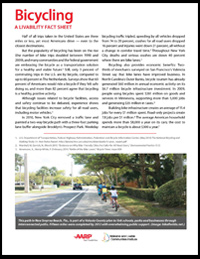AARP Hearing Center


Half of all trips taken in the United States are three miles or less, yet most Americans drive — even to the closest destinations. Only 3 percent of commuting trips in the U.S. are by bicycle, compared to up to 60 percent in The Netherlands.


Download the Bicycling Fact Sheet:
Still, it’s not unreasonable to believe we can improve our numbers, especially since the popularity of bicycling has been on the rise. The number of bike trips doubled between 1990 and 2009, and many communities and the federal government are embracing the bicycle as a transportation solution for a healthy and viable future
The Bicycling fact sheet offers tips for making a community more bicycle-friendly and explains how bicycling features (such as dedicated bike lanes) help improve a community's safety and economic success. Two examples:
- After bike lanes were installed on certain New York City streets, deaths and serious crashes on those streets decreased by 40 percent.
- Building bicycling infrastructure creates an average of 11.4 jobs for every $1 million spent. Road-only projects create 7.8 jobs per $1 million.
Key Points
The authors address various myths about bicycles. Here are a few:
- Myth: “Bicycling is too dangerous.”
There were no bicycling fatalities in bicycle-friendly Portland, Oregon, in 2013 even though bicycling accounts for at least 6 percent of all trips. By comparison, 21 people were killed while driving or riding in a motor vehicle in Portland that same year.
- Myth: “Bicycle lanes hurt business.”
After the installation of protected bike lanes on New York City’s 8th and 9th avenues in the fall of 2007, retail sales increased 49 percent in those areas compared to 3 percent in the rest of Manhattan.
Success stories are provided from cities in California (Palo Alto), Indiana (Indianapolis) and Tennessee (Memphis):
- After optimizing certain boulevards for bicycle travel, the percentage of Palo Alto residents commuting to work by bicycle increased from 5.6 percent of residents in 2000 to 7.1 percent of residents in 2010.
- A walk-bike trail connecting downtown Indianapolis to a half-dozen emerging cultural districts nearby helped turn a former industrial wasteland into an area filled with museums, lawns and attractions (and generate more than $850 million to the local economy, so far).
- The Broad Avenue Arts District in Memphis got a big boost when bicycle-friendly measures were instituted. “The lanes slowed down traffic and people started noticing the businesses more,” says Pat Brown, co-owner of T Clifton Art Gallery. “Our revenues have grown on average 30 percent per year. Yes, that’s for an art-related business in a tough economy.”
How to Use
Because the fact sheets in the Livability series are only four pages each, the materials are quick and easy to read online or to download and print for sharing.
The "Bicycling" fact sheet can be used by policy makers, transportation planners, community leaders and citizen activists to educate themselves and others about the neighborhood benefits of bicycling.
The page "How to Get it Right" offers steps advocates and community leaders can take to encourage bicycling and bicycle-friendly streets and places.
Starting small, such as by striping a bike lane in an area with high bicycling potential, is one doable option. Larger scale efforts can include establishing a short-term bicycle rental or "bike share" program, such as those now up and running in places including New York City, Washington, D.C., and Paris, France.
Fact sheet published Spring 2014



























































